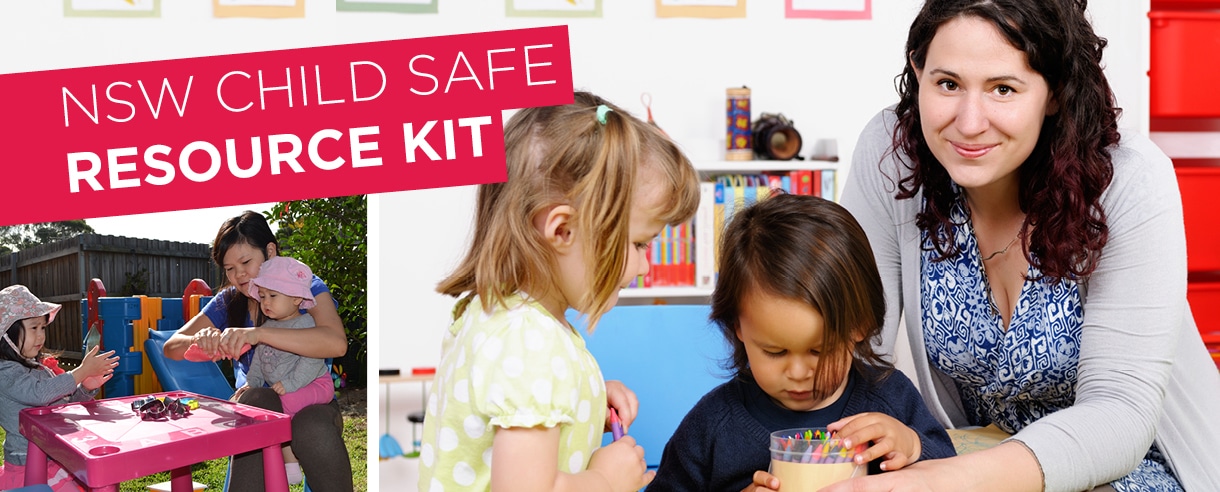
CHILD SAFE RESOURCE KIT
Is your Family Day Care service ‘Child Safe’?
All of us involved in the FDC sector who spend our days ensuring children are educated and cared for in the best way possible, would naturally like to believe that our organisations are child safe.
But are they?
Is there more that can be done to ensure that your organisation is doing its utmost to safeguard children from harm?
Harm in this context is:
- physical
- sexual
- emotional or psychological
harm caused by racial, cultural, religious discrimination or lack of cultural sensitivity that might occur in a FDC setting.
The best way for a FDC service to ensure it is child safe is by implementing policies and practices to reduce risks and by educating educators and staff about appropriate and acceptable behaviour.
A Child Safe organisation is defined by the NSW Office of the Children’s Guardian as one that:
- develops child safe policies
has a child safe code of conduct - ensures effective staff recruitment and training
- understands privacy considerations
- has a plan for managing risk
encourages children and young people to participate - effectively deals with concerns or complaints about behaviours towards a child
- attends child safe organisations training.
CHILD SAFE PD SESSION
CHILD SAFE POLICY
CHILD SAFE CODE OF CONDUCT
CHILD SAFE SELF ASSESSMENT TOOL
CHILD SAFE PD SESSION
This PowerPoint presentation is designed to be delivered by FDC services to groups of educators when introducing the concept of Child Safe Organisations to a service.
The notes section of the Powerpoint has notes for whoever will be facilitating the session. N.B. The bold bits in the notes are directions to the Facilitator and are not to be read aloud. The unbold pieces can be read to participants as is or adapted for your service’s situation.
The child safe approach requires education of educators and other FDC staff about appropriate and acceptable behaviours with children in care.
Ensuring an FDC has a child safe policy, a child safe code of conduct and offers regular training about child safe principles to all staff are important components of making your FDC child safe.
This 30–40 minute professional development session can be adapted for new or existing FDC educators.
Download Child safe PD Session
Use this PowerPoint presentation and accompanying facilitator notes to deliver a Professional Development session for your educators about your service’s commitment to creating a child safe organisation.
CHILD SAFE POLICY
All FDC organisations must have a Child Safe policy – under Regulation 168 services must have a policy about providing a child safe environment – for many services this might be your organisation’s child protection policy.
This particular Child Safe policy describes an organisation’s commitment to safeguard children from harm within the service.
A Child Safe policy:
- helps to ensure a FDC has done its best to be a safe environment for children in its care;
- demonstrates that the FDC takes its duty to ensure children’s safety from physical, emotional or sexual harm seriously; and
- gives guidelines for how the FDC service should act to ensure children are safe within its care.
Your child protection policy may cover some of the same areas as this policy, so you will need to assess whether you need to:
- Include the material in this policy within your child protection policy.
- Adopt this as a separate stand-alone policy.
- Remove some of these areas from your existing child protection policy and then adopt this Child Safe Policy.
Best practice would be to have a specific child safe policy as well as a broader child protection policy.
Child Safe Draft Policy
Download, adapt and adopt this draft policy for your FDC service.
CHILD SAFE CODE OF CONDUCT
Your FDC should have a code of conduct to remove uncertainty about what behaviour is OK with children at your service.
What is a code of conduct?
A code of conduct is a code of behaviour that outlines your FDC’s values and provides clear expectations for:
- personal and professional boundaries
- ethical behaviour
- appropriate and inappropriate behaviour and relationships for educators, staff, parents and families
How can it be used?
- As part of educator induction training
- As part of your introduction to families to your service
- Refer to it in recruitment of educators and families
- As a regular item at educator meetings
What makes codes of conduct work?
Codes of conduct have been shown to be most effective when they are:
- short
- clear
- promoted
- enforced; and
- regularly reviewed.
How do you develop one for your service?
Use the following as a guide. Involve everyone in deciding what should be in it. Remember if it is short and unambiguous it is more likely to be followed.
Sample Code of Conduct
Download, adapt and adopt this sample Code of Conduct document for your FDC service.
CHILD SAFE SELF-ASSESSMENT TOOL
Use this online tool to assess your FDC service’s current capacity to meet child safety and regulatory requirements.
The tool enables FDC services to self-assess and print a report, with suggestions to upgrade their policies and procedures.

This resource has been provided by the Department of Education as part of the Early Childhood Education and Care Sector Development Program.

